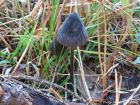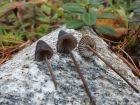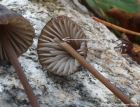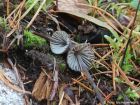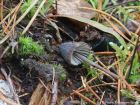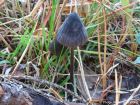Cap conical to bell-shaped when young, later becoming more flattened with a slightly depressed centre. It is sulcate and translucent-striate, at first pruinose and dull, sometimes with a faint sheen. The surface is dark brown to nearly black at the centre, often appearing bluish grey or bluish black when fresh. Towards the margin it is dark sepia-brown. The flesh is thin and whitish. Gills 15–18 reaching the stipe, ascending, narrowly adnate to shortly decurrent with a small tooth, becoming interveined with age. They are white when young, later turning greyish or brownish with a whitish edge. Stem slender, hollow, equal or slightly compressed, straight to curved, pruinose when young and gradually glabrescent except near the apex. It exudes a distinct milky white fluid when broken. The colour is dark brown above, almost black towards the base, which is densely covered with coarse whitish fibrils. The stem has no ring. Spore print white.
Microscopic Features: Spores are smooth, ellipsoid to cylindrical, measuring 10–14 × 5–6 μm, and amyloid. Basidia are 4-spored. Cheilocystidia are fusiform to lageniform with long necks, 39–95 × 8–18 μm, often striate and occasionally with lateral or apical outgrowths.
Mycena galopus var. leucogala on the mycena.no Web site.
Many mushrooms are poisonous, and some can be lethally toxic. Distinguishing between edible and poisonous mushrooms can be very challenging. Therefore, we strongly advise against consuming wild mushrooms. This website does not contain any information about the edibility or toxicity of mushrooms.
Although efforts have been made to ensure accuracy on this website, the information may contain errors and omissions. Therefore, all content provided is for educational and informational purposes only and should not be relied upon or used as a basis for consuming any plants or mushrooms.
External links are provided for reference only. We do not endorse or take responsibility for the content, advice, or products found on these sites or in any advertisements shown on this website.
